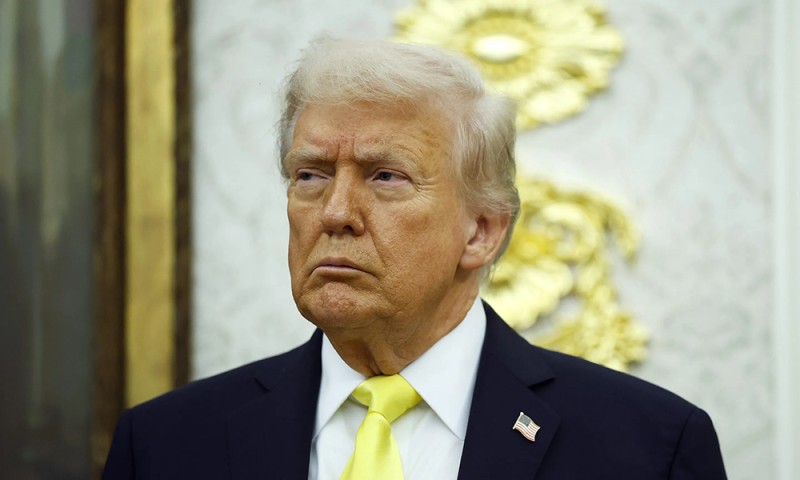
标普全球的报告指出,特朗普的关税政策正引发一场万亿美元级别的企业成本压力,其中大部分成本不可避免地落在了消费者的肩上。
这份于上周四发布的报告称,今年企业的损失将比年初预期至少增加1.2万亿美元。标普全球(S&P Global)又称,报告还反映了薪资上涨、能源价格以及资本支出增加(尤其是在AI基础设施领域)等因素。
标普全球预计今年企业支出将达到53万亿美元,修正了其1月1日的预测。该报告的分析基于超过15,000名分析师对约9,000家上市公司的预测,这些公司总市值为111万亿美元,约占全球130万亿美元股票总市值的85%。
报告称,“全球企业利润率预期已大幅收缩”,卖方分析师所覆盖公司的利润损失约为0.64%,即9070亿美元。这一“差额”大致由营收预测上调6000亿美元和盈利预测下调3000亿美元共同构成。
卖方分析师覆盖沃尔玛(Walmart)、亚马逊(Amazon)和开市客(Costco Wholesale)等全球最大零售商。在估计的9070亿美元损失中,约三分之二(5920亿美元)正通过涨价转嫁给消费者。
报告称,“三分之一(3150亿美元)通过企业利润降低在内部消化。”
但“实际产出”正在下降,意味着这些公司实际生产的商品数量正在减少。
该分析的范围超出了这9,000家上市公司,还包括了“未被覆盖的上市公司”约1550亿美元的预测额外支出,以及由私募股权和风险投资支持的公司约1230亿美元的额外支出。报告称,这些加在一起,使得2025年的总增量成本达到1.2万亿美元。
关于谁在承受关税推动的物价上涨的主要冲击,争论仍在激烈进行。
由唐纳德·特朗普任命的美联储理事克里斯托弗·沃勒(Christopher Waller)在上周四的一次演讲中表示,关税对通胀的影响不大,且主要由高收入家庭感受,因为“收入最高的10%人群占个人消费的22%”。沃勒补充说,支出数据表明“沿着收入阶梯向下”,通胀影响微乎其微甚至没有,任何价格压力都未显著削弱较不富裕家庭的购买力。
但TS Lombard的分析师认为,关税带来的经济影响因收入而异,差异显著:富裕阶层基本未受影响,可自由支配支出依然强劲,而中低收入家庭则承担了大部分困难。TS Lombard的达里奥·帕金斯(Dario Perkins)将这种情况描述为“富人在开派对,穷人却在经历衰退。”
专家告诉《财富》,关税通常扮演着“累退税”的角色,这意味着低收入消费者受到价格上涨的影响尤为严重。
昆尼皮亚克大学(Quinnipiac University)国际商务教授穆罕默德·埃拉希(Mohammad Elahee)告诉《财富》:“对高收入家庭来说,这种影响微乎其微。”他补充说,奢侈品在全球市场上通常维持着价格溢价,与关税无关。“这些消费者拥有财务灵活性,能够吸收增加的成本,而不会显著改变其购买行为或生活方式。”
全球金融机构Natixis CIB Americas的经济学家克里斯托弗·霍奇(Christopher Hodge)告诉《财富》,关税从低收入者收入中拿走的比例更大,因为中低收入家庭将其收入的更大部分用于购买商品(其中许多现在已被加征关税)而非服务。
“对关税敏感的类别——如家具、服装、电子产品和家用电器——主要由正在布置家居和抚养孩子的年轻家庭和中等收入家庭大量消费,”他说。
白宫表示,美国消费者承受的压力将是暂时的。
白宫发言人库什·德赛(Kush Desai)在给《财富》的一份声明中表示:“总统和政府的立场一直很明确:虽然关税颠覆了使美国沦为末位的破碎现状,美国人可能会面临一个过渡期,但关税的成本最终将由外国出口商承担。”
“企业已经在调整和多元化其供应链以应对关税,包括将生产回流至美国,”他补充道。
标普全球的报告称,企业利润损失可能高于其“高度保守”的估计。
报告称:“由于没有分析师覆盖的公司通常规模较小且业务多元化程度较低,这1.2万亿美元应被视为下限,而非上限。”(*)
译者:中慧言-王芳
标普全球的报告指出,特朗普的关税政策正引发一场万亿美元级别的企业成本压力,其中大部分成本不可避免地落在了消费者的肩上。
这份于上周四发布的报告称,今年企业的损失将比年初预期至少增加1.2万亿美元。标普全球(S&P Global)又称,报告还反映了薪资上涨、能源价格以及资本支出增加(尤其是在AI基础设施领域)等因素。
标普全球预计今年企业支出将达到53万亿美元,修正了其1月1日的预测。该报告的分析基于超过15,000名分析师对约9,000家上市公司的预测,这些公司总市值为111万亿美元,约占全球130万亿美元股票总市值的85%。
报告称,“全球企业利润率预期已大幅收缩”,卖方分析师所覆盖公司的利润损失约为0.64%,即9070亿美元。这一“差额”大致由营收预测上调6000亿美元和盈利预测下调3000亿美元共同构成。
卖方分析师覆盖沃尔玛(Walmart)、亚马逊(Amazon)和开市客(Costco Wholesale)等全球最大零售商。在估计的9070亿美元损失中,约三分之二(5920亿美元)正通过涨价转嫁给消费者。
报告称,“三分之一(3150亿美元)通过企业利润降低在内部消化。”
但“实际产出”正在下降,意味着这些公司实际生产的商品数量正在减少。
该分析的范围超出了这9,000家上市公司,还包括了“未被覆盖的上市公司”约1550亿美元的预测额外支出,以及由私募股权和风险投资支持的公司约1230亿美元的额外支出。报告称,这些加在一起,使得2025年的总增量成本达到1.2万亿美元。
关于谁在承受关税推动的物价上涨的主要冲击,争论仍在激烈进行。
由唐纳德·特朗普任命的美联储理事克里斯托弗·沃勒(Christopher Waller)在上周四的一次演讲中表示,关税对通胀的影响不大,且主要由高收入家庭感受,因为“收入最高的10%人群占个人消费的22%”。沃勒补充说,支出数据表明“沿着收入阶梯向下”,通胀影响微乎其微甚至没有,任何价格压力都未显著削弱较不富裕家庭的购买力。
但TS Lombard的分析师认为,关税带来的经济影响因收入而异,差异显著:富裕阶层基本未受影响,可自由支配支出依然强劲,而中低收入家庭则承担了大部分困难。TS Lombard的达里奥·帕金斯(Dario Perkins)将这种情况描述为“富人在开派对,穷人却在经历衰退。”
专家告诉《财富》,关税通常扮演着“累退税”的角色,这意味着低收入消费者受到价格上涨的影响尤为严重。
昆尼皮亚克大学(Quinnipiac University)国际商务教授穆罕默德·埃拉希(Mohammad Elahee)告诉《财富》:“对高收入家庭来说,这种影响微乎其微。”他补充说,奢侈品在全球市场上通常维持着价格溢价,与关税无关。“这些消费者拥有财务灵活性,能够吸收增加的成本,而不会显著改变其购买行为或生活方式。”
全球金融机构Natixis CIB Americas的经济学家克里斯托弗·霍奇(Christopher Hodge)告诉《财富》,关税从低收入者收入中拿走的比例更大,因为中低收入家庭将其收入的更大部分用于购买商品(其中许多现在已被加征关税)而非服务。
“对关税敏感的类别——如家具、服装、电子产品和家用电器——主要由正在布置家居和抚养孩子的年轻家庭和中等收入家庭大量消费,”他说。
白宫表示,美国消费者承受的压力将是暂时的。
白宫发言人库什·德赛(Kush Desai)在给《财富》的一份声明中表示:“总统和政府的立场一直很明确:虽然关税颠覆了使美国沦为末位的破碎现状,美国人可能会面临一个过渡期,但关税的成本最终将由外国出口商承担。”
“企业已经在调整和多元化其供应链以应对关税,包括将生产回流至美国,”他补充道。
标普全球的报告称,企业利润损失可能高于其“高度保守”的估计。
报告称:“由于没有分析师覆盖的公司通常规模较小且业务多元化程度较低,这1.2万亿美元应被视为下限,而非上限。”(*)
译者:中慧言-王芳
President Donald Trump’s tariffs are leading a trillion-dollar corporate squeeze, most of which is inevitably falling on consumers’ shoulders, an S&P Global report finds.
Companies will lose at least $1.2 trillion more this year than they expected before the year began and the picture on trade and tariffs dramatically changed, according to the report, published Thursday. It also reflects factors including wage increases and energy prices, and rising capital expenditure, particularly in AI infrastructure, S&P added.
S&P estimates $53 trillion in company expenses for this year, revising its January 1 forecast. The report’s analysis pulled from forecasts from more than 15,000 analysts following roughly 9,000 public companies, which represent $111 trillion of the $130 trillion global equity market, or some 85%.
“Global corporate margin expectations have contracted sharply” by about 0.64%, or $907 billion in lost profit among firms covered by sell-side analysts, the report said. This “wedge” is roughly made up of an increase of $600 billion in revenue forecasts and a $300 billion fall in earnings estimates.
Sell-side analysts cover the largest global retailers like Walmart, Amazon and Costco Wholesalers. Of the estimated $907 billion lost, roughly two-thirds, or $592 billion, is being passed to consumers via higher prices.
“One-third ($315 billion) is absorbed internally through lower earnings,” the report said.
But “real output” is declining, meaning fewer goods are actually being produced by these companies.
The analysis extends beyond the 9,000 public firms to include increased forecasted expenses of about $155 billion for “uncovered public firms” as well as $123 billion for private equity- and venture capital-backed firms. Together, this brings the total incremental cost to $1.2 trillion in 2025, according to the report.
Debate still rages over who’s shouldering the brunt of tariff-driven price hikes.
Trump-appointed Fed Governor Christopher Wallersaid in a speech on Thursday effects of tariffs on inflation have been modest and mostly felt by higher-income households, as “the highest-earning 10% account for 22% of personal consumption.” Spending data indicate little to no inflationary effect “down the income scale,” and any price pressures have not significantly eroded the purchasing power of less affluent households, Waller added.
But analysts from TS Lombard argue the economic fallout from tariffs is starkly divided by income, saying the wealthy are largely insulated and continue strong discretionary spending, while lower- and middle-income households bear most of the hardship. TS Lombard’s Dario Perkins described the situation as “the rich are having a party, and the poor are having a recession.”
Experts tell Fortune tariffs usually act as a “regressive tax,” meaning lower-income consumers are disproportionately affected by the price increases.
“For higher-income households, this impact is minimal,” Mohammad Elahee, professor of international business at Quinnipiac University, told Fortune. Luxury goods often maintain a price premium across global markets regardless of tariffs, he added. “These consumers possess the financial flexibility to absorb increased costs without significantly altering their purchasing behavior or lifestyle,”
Christopher Hodge, an economist at Natixis CIB Americas, a global financial institution, told Fortune tariffs take a larger percentage of income from lower earners since low- and middle- income households spend a greater share of their paycheck on goods—many of which are now tariffed—rather than services.
“Tariff-sensitive categories—like furniture, apparel, electronics, and household appliances—are heavily consumed by younger families and middle-income households outfitting homes and raising children,” he said.
The White House says American consumer strain will be transitory.
“The President and Administration’s position has always been clear: while Americans may face a transition period from tariffs upending a broken status quo that has put America Last, the cost of tariffs will ultimately be borne by foreign exporters, White House spokesperson Kush Desai (库什·德赛) told Fortune in a statement.
“Companies are already shifting and diversifying their supply chains in response to tariffs, including by onshoring production to the United States,” he added.
The S&P report said corporate profit loss may be higher than its “highly conservative” estimate.
“Because firms without analyst coverage tend to be smaller and less diversified, the $1.2 trillion should be viewed as a floor, not a ceiling,” the report said.

